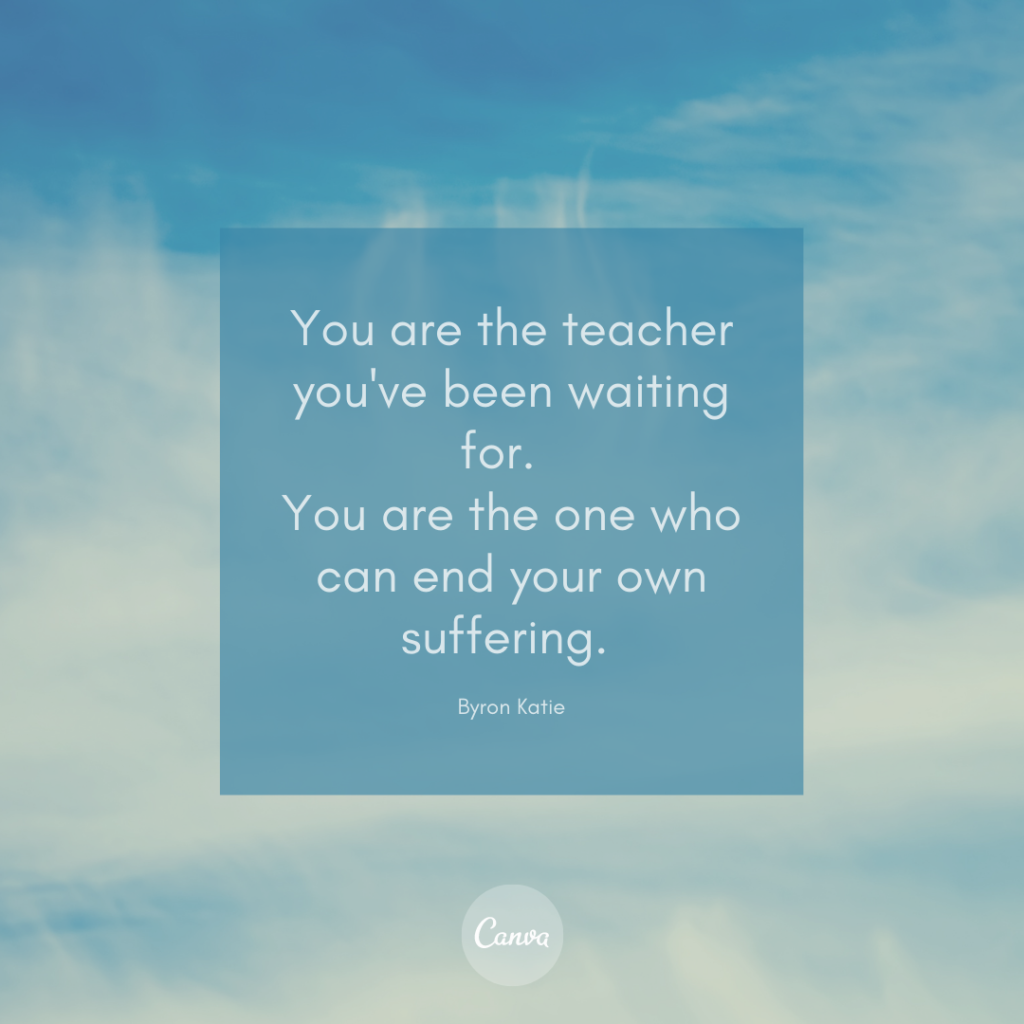It’s not difficult to look at the state of our country (and the world) and witness fear fueling panic and chaos. Fear is contagious and can produce stressful thoughts such as: “What’s going to happen next? What’s going to happen to me and my family? What’s wrong with people? Where’s the good?”
Fearful thoughts like those were ping-ponging in my mind as I walked on a wooded trail by my house. Every weekday, as part of my morning-moving meditation, I bike, hike, walk or run while listening to something spiritually motivating.
This particular morning it was snowing, and I was listening to Byron Katie (Katie) work her miracles with participants on her weekly Zoom sessions. If you’re unfamiliar with Katie, her work is remarkable. Using her teaching, I’ve healed many stressful thoughts (that I believed were hopeless), including a deep resentment about my mother’s illness and death. Tony Robbins commented about Katie’s work:
I think Byron Katie is just a real thing. She’s pure and her intent is only to serve—she brings people back to reality so quickly.
Tony Robbins
Becoming aware of my fearful thoughts, I stopped and turned my face up to the falling snow. I went deep within, connected with my core Self, and prayed. I prayed to be shown the truth (not my ideas about the truth) but the real truth. And as I watched the big flakes fall and felt them melt on my face, a real truth emerged —
FEARFUL THOUGHTS ARE FROM THE MIND—NOT GOD
Our conditioned thinking produces fear in our minds. God, the Divine, or Universal Intelligence that dwells deep within us (beyond the thinking mind) is where all real truth resides. Exposing stressful thoughts to the light of deep truth is what The Work of Byron Katie is all about.
WHAT IS THE WORK?
The Work is learning to question thoughts that are painful or stressful to you. Simply by asking four questions and listening to the answers within yourself, you open your mind to profound and life-transforming insights.

Transformation begins by realizing a fundamental truth: “we are not disturbed by what happens to us, but by our thoughts about what happens.” — The Greek Philosopher, Epictetus
The Work’s four questions reveal where our thinking isn’t true for us. Whenever we experience a stressful feeling — from slight irritation to intense fear, rage, or sorrow — Katie says we can be certain there’s a specific thought causing the trouble.
The Work doesn’t stem from any philosophical or religious tradition. Katie says The Work will join and enhance any program or religion you have. If you don’t have a religion, it will simply bring you joy.
“It is American, homegrown, and mainstream, having originated in the mind of an ordinary woman who had no intention of originating anything.”
Loving What Is — Byron Katie & Stephen Mitchell
Learning How to do The Work
Katie says that everyone learns The Work in their own way. Some learn by watching it performed live with participants, while others learn by doing The Work, pen and paper in hand. I found that watching Katie perform The Work live and then writing out my own stressful thoughts worked best for me.
One of the most important principles of the work is that no teacher is necessary. You can do this on your own.

Katie teaches that the only time we suffer is when we believe a thought that argues with reality. Even though it’s hopeless to want reality to be different than it is, we argue with it several times a day.
“The media should stop fueling fear and panic.” “People should stop hurting others and themselves.” Or simply, “My kids should clean up after themselves.”
These thoughts argue with what’s actually happening — with reality. And since we believe it should be different than it actually is, we suffer.
Offering no resistance to what is doesn’t mean being passive, losing the desire to take action, or condoning harmful behavior. It simply means that we don’t create inner struggle and suffering because we think it shouldn’t have happened. It did happen. And no amount of thinking or wishing will ever change that.
Doing The Work
The concept of non-resistance to a painful reality took me a while to embrace.
I unleashed a tirade of inner resistance and blame when my mother was diagnosed with smoking-related esophageal cancer in 2015: “She shouldn’t have ever smoked.” “She should have stopped smoking much sooner.” “She shouldn’t have been so selfish.”
Due to my inner turmoil and resistance to the reality that she did smoke and developed cancer as a result, I was unable to be fully present with her during her illness and death.
I didn’t discover The Work until after my mom’s death. But it doesn’t matter if the stressful thought is about someone deceased, a natural disaster, or an organization, it still works. Below is how I used The Work on the painful thoughts about my mom.
The 4 Questions and Turnarounds
Question
You begin by questioning a stressful thought. Then, you get very still, go inside yourself, meditate on the question, listen, and wait for the answer.
The Four Questions
- Is it true? Yes or no. If no, move to question 3.
- Can you absolutely know that it’s true? Focus on the situation your questioning. Look again at that moment in time and see what reveals itself to you.
- How do you react, what happens, when you believe that thought?
- Who would you be without that thought?
The Turnaround
Turn the thought around. Is the opposite as true as or truer than the original thought?
Katie points out that it’s important to write out your questions and answers rather than trying to do it in your head. Use a blank sheet of paper or download a worksheet at TheWork.com.
Mind’s job is to be right, and it can justify itself faster than the speed of light. Stop the portion of your thinking that is the source of your fear, anger, sadness, or resentment by transferring it to paper. Once the mind is stopped on paper, it’s much easier to investigate. Eventually, The Work begins to undo you automatically, even without writing.
Byron Katie
1. Is it True? (Yes or no. If no, move to question 3).
The main thought about my mom that repeated itself was, “Mom was stubborn and selfish and cared more about smoking than she did about herself, her children, and specifically me.”
Is it true? No. I found many instances when she giving, loving, and caring while she was smoking. (Since the answer was no, move to question 3.)
3. How do you react, what happens, when you believe that thought?
When I believed that mom was stubborn and selfish and cared more about smoking than she did about me, I had resentment, hurt, and anger towards her. I avoided her. I couldn’t think of her or be in her presence without those painful feelings coming to the surface.
4. Who would you be without that thought?
Without the thought, I would have seen her for the loving, caring, and devoted mother that she was. I would have been able to be present with her during her illness and death. And I would have been the loving, caring, and devoted daughter she needed me to be.
The Turnaround: I was stubborn and selfish and cared more about her smoking than I did about her. I justified that berating her for smoking was because I loved her and wanted her to be healthy — which was true. But, what was truer, was that I didn’t want her to get cancer and leave me.
I didn’t care that nicotine changed her brain chemistry, stimulating the pleasure centers of her brain, making it so difficult for her to quit. And I didn’t care that smoking was a comfort and a way to relieve stress and anxiety for her. I cared about myself. And how her actions would affect me.
The Turnarounds are not about blaming yourself or feeling guilty. It’s about discovering alternatives that can bring you peace.
Doing The Work on my mom allowed me to release the hurt, anger, and resentment that continued after her death. I finally found peace in understanding that we were both simply doing the best we could with what we knew at the time and that pure love had always surrounded all of it.
Let me know in the comments if you do The Work on a stressful thought and how it “works” for you.
Header Photo courtesy of AMcKinley Photography



I never thought about writing down my troubling thuoghts and answering the questions that would help me understand why they are there, and then try to figure out if they are even valid. Very helpful advice that I will follow. Thank you.
That’s awesome Claudia! Let me know how it works for you.
To find a way to turn bitterness and resentment into understanding is an awesome thing. I’m loving your journey
Thanks, Wanda! XOXO
Turn around is powerful like the song “Both sides now” Makes sense, Thanks.
Ahh.. the brilliant Joni Mitchell. Yes, seeing from both sides is all the difference in the world. Thanks for your comment!
I needed this today. Thank you
I’m so happy that it served you! :)) Thanks for commenting, Jackie.